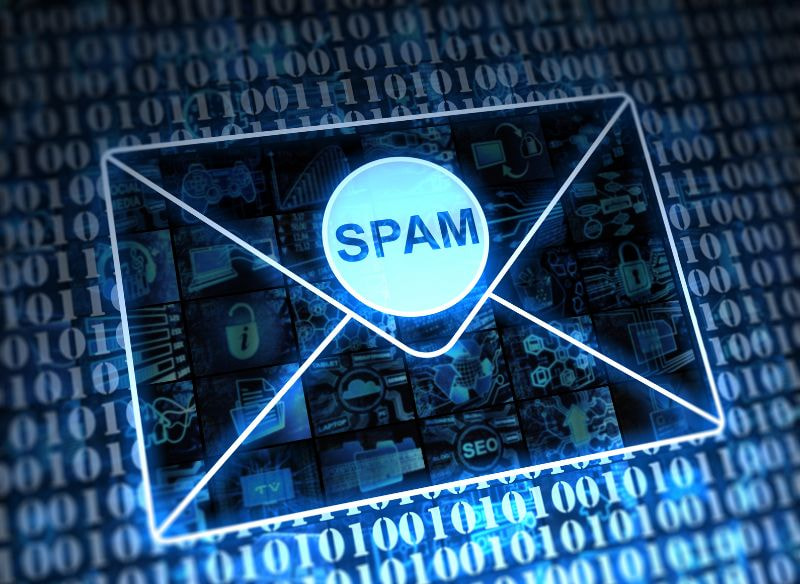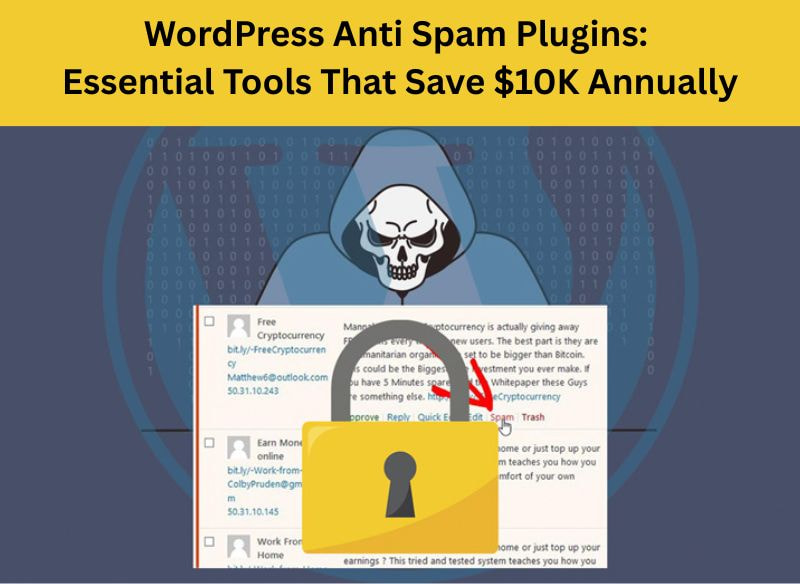No products in the cart.
WordPress Anti Spam Plugins: Essential Tools That Save $10K Annually
WordPress spam attacks have reached epidemic proportions, with over 7.5 billion spam comments blocked monthly across WordPress sites worldwide. As cyber threats evolve and automated bots become more sophisticated, choosing the right anti-spam protection has never been more critical for website owners, developers, and digital marketers.
This comprehensive guide examines the leading WordPress anti-spam plugins of 2024, providing detailed comparisons, implementation strategies, and expert insights to help you make an informed decision for your website’s security needs.
I. Understanding WordPress Anti Spam Plugins: The Hidden Threat to Your Website
WordPress spam represents one of the most persistent and damaging threats facing website owners today. Unlike visible hacking attempts, spam operates insidiously, gradually degrading your site’s performance, search rankings, and user experience while consuming valuable server resources.
1. Types of WordPress Spam Attacks
- Comment Spam Statistics and Impact: Comment spam remains the most prevalent form of WordPress spam, accounting for approximately 85% of all spam attacks. These automated attacks target your blog posts and pages, flooding comment sections with irrelevant links, promotional content, and malicious code. Studies show that unprotected WordPress sites receive an average of 150-300 spam comments daily, with high-traffic sites experiencing thousands of spam attempts.
- Contact Form Spam Exploitation: Contact form spam has surged 340% since 2022, with bots specifically targeting WordPress contact forms to inject malicious content, overload email servers, and compromise form databases. These attacks often bypass traditional comment spam filters by targeting form submission endpoints directly.
- User Registration Spam Patterns: Automated bot networks create fake user accounts at alarming rates, with some sites experiencing over 1,000 fake registrations daily. These spam accounts serve multiple malicious purposes: creating spam content, accessing restricted areas, and building networks for future attacks.
- WooCommerce Spam Orders: E-commerce spam has become a critical vulnerability, with fake orders disrupting inventory management, payment processing, and customer service operations. WooCommerce stores report spam order rates increasing by 250% year-over-year, making specialized protection essential for online retailers.
2. The Real Cost of WordPress Spam

The Real Cost of WordPress Spam
- SEO Performance Degradation: Search engines penalize sites with excessive spam content, leading to ranking drops and reduced organic visibility. Google’s algorithms specifically target comment spam, with affected sites losing an average of 35% of their search traffic within six months of spam infiltration.
- Server Resource Consumption: Each spam comment or form submission consumes server resources, including CPU cycles, memory, and bandwidth. High-volume spam attacks can overwhelm shared hosting environments, causing site slowdowns and potential downtime during traffic spikes.
- User Experience Deterioration: Legitimate visitors encounter slower loading times, cluttered comment sections, and potential security warnings when spam infiltrates your site. This degraded experience directly impacts bounce rates, conversion metrics, and user engagement.
- Brand Reputation Damage: Spam content appearing on your website reflects poorly on your brand’s professionalism and security practices. Business websites particularly suffer when clients discover spam comments or receive spam emails originating from compromised contact forms.
II. How WordPress Anti-Spam Plugins Work: Technology Behind Protection
Modern WordPress anti-spam plugins employ sophisticated technologies that go far beyond simple keyword filtering, utilizing advanced machine learning algorithms and cloud-based intelligence networks to identify and block spam in real-time.
1. Machine Learning Spam Detection Methods
- Behavioral Analysis Algorithms: Advanced plugins analyze user behavior patterns, including mouse movements, typing cadence, and navigation patterns to distinguish between human users and automated bots. These behavioral signals create unique fingerprints that help identify suspicious activity before spam content is submitted.
- Pattern Recognition Systems: Machine learning models trained on millions of spam samples can identify subtle patterns in content structure, language usage, and submission timing that indicate spam activity. These systems continuously evolve, adapting to new spam techniques and improving accuracy over time.
- Real-Time Threat Assessment: Cloud-based systems process threat intelligence from global networks, sharing spam signatures and attack patterns across millions of protected websites. This collective intelligence enables rapid identification of emerging spam campaigns and zero-day attack methods.
2. Multi-Layer Spam Protection Strategies

Multi-Layer Spam Protection Strategies
- Cloud-Based Filtering Services: External cloud services process suspicious content before it reaches your server, reducing resource consumption and providing access to vast databases of known spam patterns. These services typically offer 99.9%+ accuracy rates and handle billions of daily checks.
- Local Detection Mechanisms: Server-side filters analyze content using local algorithms, providing privacy-focused protection that doesn’t require external data transmission. These mechanisms excel at detecting site-specific spam patterns and customized attack methods.
- Hybrid Protection Approaches: The most effective solutions combine cloud-based intelligence with local processing, creating redundant protection layers that maximize accuracy while minimizing false positives and server load.
III. Top WordPress Anti-Spam Plugins: Comprehensive Comparison
Selecting the optimal anti-spam plugin requires understanding each solution’s unique strengths, technological approach, and suitability for different website types and traffic volumes.
1. Akismet: The WordPress Standard
- Established WordPress Solution Since 2005: Akismet holds the distinction of being the original WordPress anti-spam plugin, pre-installed with every WordPress installation and trusted by millions of websites worldwide. Developed by Automattic, the company behind WordPress.com, Akismet has processed over 500 billion spam comments since its inception.
- Processes Millions of Daily Spam Checks with 99.99% Accuracy: The service handles over 100 million spam checks daily, maintaining an impressive 99.99% accuracy rate while processing less than 0.1% false positives. This remarkable precision stems from nearly two decades of spam pattern analysis and continuous algorithm refinement.
- Only Service Backed by WordPress.com Infrastructure: Akismet uniquely leverages WordPress.com’s massive infrastructure, providing unparalleled reliability and processing power. This exclusive relationship ensures optimal compatibility with WordPress core updates and seamless integration with native commenting systems. The service also maintains comprehensive backup and restore capabilities for spam filtering data, allowing administrators to recover false-positive catches and restore legitimate comments that may have been incorrectly flagged.
- Pricing and Feature Analysis: Akismet offers tiered pricing starting with a free personal plan for non-commercial sites, Plus plans at $10/month for single commercial sites, and Enterprise solutions starting at $50/month for multiple sites. The pricing structure scales based on API calls and includes features like advanced statistics, priority support, and commercial use rights.
- Best Use Cases and Limitations: Akismet excels for content-heavy websites with active commenting communities, news sites, and blogs with high user engagement. However, it focuses exclusively on comment spam and doesn’t protect contact forms, user registrations, or e-commerce platforms without additional solutions.
2. CleanTalk: Advanced Cloud Protection

CleanTalk
- Multi-Platform Cloud-Based Service: CleanTalk extends beyond WordPress to protect over 20 content management systems, including Drupal, Joomla, and custom applications. This broad compatibility makes it ideal for agencies and developers managing diverse website portfolios.
- SpamFireWall Technology with 99.998% Accuracy :CleanTalk’s proprietary SpamFireWall technology achieves an industry-leading 99.998% accuracy rate by analyzing over 40 spam indicators simultaneously. The system processes behavioral signals, content patterns, and real-time threat intelligence to make microsecond decisions on content legitimacy.
- First Invisible Protection Without User Interaction: Unlike CAPTCHA-based systems, CleanTalk operates completely invisibly to legitimate users, eliminating friction while maintaining maximum protection. This approach improves user experience and conversion rates while blocking 100% of bot traffic.
- Comprehensive Feature Breakdown: CleanTalk provides comprehensive protection including comment spam filtering, contact form security, user registration validation, WooCommerce order protection, and API spam prevention. Additional features include spam statistics, IP blacklisting, and integration with popular form plugins.
- Integration Capabilities: The plugin seamlessly integrates with over 200 WordPress plugins and themes, including Contact Form 7, Gravity Forms, WPForms, WooCommerce, BuddyPress, and bbPress. This extensive compatibility ensures protection across all website interaction points.
3. WPForms: Form-Focused Protection
WPForms includes built-in anti-spam protection specifically designed for form submissions, making it an excellent choice for lead generation websites and business sites that rely heavily on contact forms. The plugin’s spam protection integrates seamlessly with its drag-and-drop form builder, providing user-friendly implementation for non-technical users.
The Form Spam Protection feature utilizes both honeypot fields and behavioral analysis to identify bot submissions without requiring CAPTCHA verification. This approach maintains high conversion rates while effectively blocking automated spam submissions.
User-friendly implementation remains WPForms’ strongest advantage, with one-click spam protection activation and minimal configuration requirements. The visual form builder includes spam protection options directly in the interface, making it accessible to users of all technical skill levels.
4. Antispam Bee: Privacy-First Solution
Antispam Bee addresses growing privacy concerns by providing GDPR-compliant protection that processes all data locally without external API calls. This approach appeals to European websites and privacy-conscious organizations that cannot share user data with third-party services.
The plugin employs local spam detection methods including IP validation, comment content analysis, and behavioral pattern recognition. While accuracy rates may be lower than cloud-based solutions, Antispam Bee provides adequate protection for small to medium-sized websites with moderate spam volumes.
As a cost-effective alternative, Antispam Bee remains completely free while offering features comparable to premium plugins. This makes it particularly attractive for budget-conscious website owners and non-profit organizations requiring basic spam protection.
IV. Specialized Spam Protection Solutions
Different types of spam attacks require targeted protection strategies, and understanding these specialized approaches helps create comprehensive security implementations.
1. Comment Spam Protection Strategies
- Automated Comment Filtering: Advanced comment filtering systems analyze multiple factors including IP reputation, content patterns, link density, and submission timing to identify spam comments. These systems process submissions in real-time, typically making decisions within milliseconds of comment submission.
- Moderation Queue Management: Effective spam protection includes intelligent moderation queue systems that prioritize legitimate comments while quarantining suspicious content. These systems reduce administrative overhead by automatically approving trusted users while flagging questionable submissions for manual review.
- False Positive Prevention: Sophisticated algorithms minimize false positives by maintaining user reputation systems, learning from manual moderator decisions, and providing easy recovery mechanisms for mistakenly blocked legitimate comments.
2. Form Spam Protection Implementation
- Contact Form 7 Integration: Contact Form 7, used on over 5 million WordPress websites, requires specialized spam protection due to its popularity among spammers. Effective protection includes invisible honeypot fields, behavioral analysis, and integration with external spam filtering services.
- Gravity Forms Protection: Gravity Forms’ advanced features require comprehensive spam protection that works with conditional logic, multi-page forms, and payment integrations. Protection strategies include built-in spam filtering, third-party service integration, and custom validation rules.
- Custom Form Security: Custom-developed forms need tailored security implementations including server-side validation, rate limiting, and integration with existing spam protection systems. These implementations require technical expertise but provide maximum flexibility and control.
3. Spam Protection for WooCommerce

Spam Protection For WooCommerce
- Order Spam Prevention: E-commerce spam protection must balance security with user experience, preventing fake orders while ensuring legitimate customers can complete purchases smoothly. Effective strategies include payment validation, shipping address verification, and behavioral analysis during checkout.
- Fake Account Detection: Automated systems identify fake customer accounts through registration pattern analysis, email validation, and behavioral monitoring. These systems prevent spam account creation while avoiding friction for legitimate customers.
- Payment Fraud Protection: Advanced e-commerce protection includes payment fraud detection, suspicious order flagging, and integration with payment processor fraud prevention systems. These multi-layered approaches protect both merchants and customers from fraudulent transactions.
4. User Registration Spam Protection
- Automated Signup Filtering: Registration spam protection analyzes signup patterns, email domains, and user behavior to identify automated account creation attempts. These systems typically block 95%+ of spam registrations while allowing legitimate users to register without additional verification steps.
- Email Verification Systems: Double opt-in email verification remains one of the most effective methods for preventing spam registrations, though it may reduce conversion rates for legitimate users. Advanced systems balance security with user experience through intelligent verification requirements.
- Profile Validation Methods: Comprehensive registration protection includes profile completeness analysis, social media verification, and behavioral monitoring during the initial user session to identify and block spam accounts before they become active.
V. Advanced Protection Technologies
Cutting-edge anti-spam technologies employ sophisticated detection methods that go beyond traditional content filtering to identify and block modern spam techniques.
1. Bot Protection Mechanisms
- User Behavior Analysis: Modern bot detection systems analyze micro-interactions including mouse movement patterns, keystroke dynamics, and scroll behavior to distinguish between human users and automated scripts. These behavioral biometrics provide highly accurate identification without user friction.
- JavaScript-Based Detection: Client-side JavaScript challenges test browser capabilities and execution environments to identify headless browsers and automated scripts commonly used for spam submissions. These challenges operate invisibly to legitimate users while effectively blocking bot traffic.
- Browser Fingerprinting: Advanced fingerprinting techniques create unique browser profiles based on rendering capabilities, installed fonts, screen resolution, and other environmental factors. These fingerprints help identify repeat spam attempts and establish user reputation scores.
2. Spam Firewall Protection

Spam Firewall Protection
- IP-Based Filtering Systems: Real-time IP reputation systems block traffic from known spam sources, compromised machines, and suspicious geographic locations. These systems process millions of IP reputation updates daily, providing immediate protection against emerging threats.
- Geographic Blocking Options: Location-based filtering allows websites to block traffic from specific countries or regions with high spam activity rates. This approach proves particularly effective for local businesses that don’t expect international traffic.
- Real-Time Threat Blocking: Advanced firewall systems process threat intelligence feeds in real-time, immediately blocking newly identified spam sources and attack patterns. These systems typically update threat databases every few minutes, ensuring maximum protection against evolving threats.
3. Spam Protection for REST API
- API Endpoint Security: WordPress REST API protection includes authentication requirements, input validation, and rate limiting to prevent automated spam submissions through API endpoints. These protections are essential for headless WordPress implementations and mobile app integrations.
- Rate Limiting Implementation: Sophisticated rate limiting systems track request patterns by IP address, user account, and API endpoint to identify and throttle suspicious activity. These systems prevent both spam attacks and denial-of-service attempts.
- Authentication Requirements :API spam protection includes mandatory authentication for sensitive endpoints, token-based access control, and permission verification to ensure only authorized users can submit content through API interfaces.
VI. Enhancing Protection with Additional Tools
Comprehensive spam protection often requires supplementary tools and techniques that work alongside primary anti-spam plugins to create robust, multi-layered security.
1. CAPTCHA Integration Options
- Google reCAPTCHA Implementation: Google reCAPTCHA v3 provides invisible bot protection by analyzing user behavior and assigning risk scores without requiring user interaction. This approach maintains user experience while providing effective bot detection, though it requires sharing user data with Google.
- hCAPTCHA Alternatives: Privacy-focused alternatives like hCAPTCHA offer similar protection without Google’s data collection practices. These services provide comparable accuracy while addressing privacy concerns and reducing dependency on single-vendor solutions.
- User Experience Considerations: CAPTCHA implementation requires careful balance between security and usability. Modern invisible CAPTCHAs provide better user experience than traditional image recognition challenges while maintaining effective bot protection.
2. Honeypot Spam Protection

Honeypot Spam Protection
- Invisible Field Techniques: Honeypot fields remain one of the most effective spam prevention methods, using hidden form fields that legitimate users cannot see but automated bots typically fill out. These techniques are simple to implement and highly effective against basic spam bots.
- Bot Trap Mechanisms: Advanced honeypot implementations include multiple trap types such as CSS-hidden fields, time-based submission analysis, and mouse movement tracking. These multi-faceted approaches catch sophisticated bots that might bypass simple hidden field traps.
- Implementation Best Practices: Effective honeypot implementation requires careful field naming, proper CSS hiding techniques, and graceful handling of false positives. Best practices include using realistic field names and providing clear error messages for accidentally triggered traps.
3. Email Spam Protection
- SMTP Security Measures: Email protection includes SMTP authentication, encrypted transmission, and reputation management to ensure legitimate emails reach recipients while preventing spam from using your email infrastructure.
- Email Validation Systems: Real-time email validation services verify email address existence, domain validity, and reputation before allowing form submissions. These services prevent fake email submissions while maintaining deliverability for legitimate communications.
- Delivery Optimization: Email deliverability optimization includes proper SPF, DKIM, and DMARC configuration to ensure legitimate emails reach recipients’ inboxes rather than spam folders. These technical implementations are crucial for maintaining communication effectiveness.
VII. Monitoring and Management
Effective spam protection requires ongoing monitoring, analysis, and optimization to maintain high protection levels while minimizing false positives and performance impact.
1. Spam Analytics and Reporting
- Performance Metrics Tracking: Comprehensive analytics include spam detection rates, false positive percentages, blocked attack volumes, and protection effectiveness trends. These metrics help optimize configuration settings and demonstrate security value to stakeholders.
- Threat Intelligence Gathering: Advanced reporting systems provide insights into attack patterns, geographic origins, and emerging spam techniques. This intelligence helps anticipate future threats and adjust protection strategies proactively.
- ROI Measurement Tools: Quantitative analysis of spam protection includes time savings calculations, server resource preservation, and SEO impact measurements. These metrics help justify security investments and optimize protection strategies.
2. IP and Blacklist Management

IP and Blacklist Management
- Manual IP Blocking: Administrative controls for manual IP blocking provide immediate response capabilities for persistent spam sources. These tools should include temporary blocking options, whitelist overrides, and detailed logging for audit purposes.
- Automated Blacklist Updates: Real-time blacklist synchronization ensures immediate protection against newly identified spam sources. These automated systems typically update every few minutes and include reputation scoring for more nuanced blocking decisions.
- Whitelist Configuration: Whitelist management allows trusted users, IP ranges, and email domains to bypass spam filtering. These configurations are essential for ensuring important communications aren’t accidentally blocked by overly aggressive filtering.
VIII. Implementation Best Practices
Successful spam protection implementation requires careful planning, proper configuration, and ongoing optimization to achieve maximum effectiveness without negatively impacting legitimate users.
1. Plugin Selection Criteria
- Site Size and Traffic Considerations: High-traffic websites require cloud-based solutions with robust infrastructure, while smaller sites may benefit from lightweight, local processing options. Consider your average daily traffic, peak load requirements, and growth projections when selecting plugins.
- Budget and Feature Requirements: Evaluate total cost of ownership including plugin licenses, API usage fees, and administrative time requirements. Premium plugins often provide better accuracy and support, but free solutions may suffice for basic protection needs.
- Technical Complexity Assessment: Consider your technical expertise and available development resources when choosing between simple plug-and-play solutions and advanced configurable systems. Complex implementations may provide better protection but require ongoing technical maintenance.
2. Configuration and Optimization

Configuration And Optimization
- Initial Setup Procedures: Proper initial configuration includes baseline security settings, integration with existing systems, and testing with known spam samples. Document all configuration decisions and maintain backup configurations for quick recovery.
- Performance Tuning Tips: Optimize spam protection performance through caching integration, database query optimization, and resource usage monitoring. Regular performance testing ensures protection systems don’t negatively impact site speed or user experience.
- Regular Maintenance Tasks: Ongoing maintenance includes updating spam definitions, reviewing false positive reports, monitoring system performance, and adjusting configuration based on changing spam patterns. Schedule regular reviews to ensure continued effectiveness.
3. Testing and Validation
- Protection Effectiveness Measurement: Regular testing with known spam samples and penetration testing helps validate protection effectiveness. These tests should include various spam types and attack vectors to ensure comprehensive protection.
- False Positive Monitoring: Systematic monitoring of blocked legitimate content helps optimize filtering sensitivity and prevent business impact. Establish clear processes for investigating and resolving false positive reports.
- User Experience Impact Assessment: Regular user experience testing ensures spam protection doesn’t create friction for legitimate users. Monitor conversion rates, form completion rates, and user feedback to identify potential issues.
IX. Troubleshooting Common Issues
Even the best-configured spam protection systems may encounter issues that require systematic troubleshooting and resolution to maintain optimal performance.
1. Performance Impact Mitigation
- Server Resource Optimization: Monitor CPU usage, memory consumption, and database performance to identify spam protection resource requirements. Optimize through efficient caching, database indexing, and query optimization techniques.
- Caching Compatibility: Ensure spam protection works correctly with caching plugins and CDN services. Some protection methods may conflict with aggressive caching, requiring careful configuration to maintain both security and performance.
- Loading Speed Maintenance: Regular speed testing ensures spam protection doesn’t negatively impact page load times. Use tools like GTmetrix and Google PageSpeed Insights to monitor performance and identify optimization opportunities.
2. False Positive Management

False Positive Management
- Legitimate Content Rescue: Establish clear procedures for identifying and recovering legitimate content mistakenly flagged as spam. These procedures should include rapid response protocols and preventive measures to avoid similar issues.
- Whitelist Configuration: Proper whitelist management ensures trusted users and content sources bypass spam filtering while maintaining security. Regularly review and update whitelists based on changing business requirements.
- User Communication Protocols: Clear communication procedures help users understand spam protection measures and provide feedback on filtering issues. Establish contact methods and response timeframes for spam protection concerns.
X. Frequently Asked Questions
What Is The Best Free WordPress Anti-Spam Plugin For Small Businesses?
Antispam Bee offers free, privacy-focused WordPress spam protection for small businesses, handling moderate spam volumes without external dependencies or commercial restrictions. Unlike Akismet’s limitations, it ensures GDPR compliance through local processing. However, high-traffic sites or those needing form protection should consider premium alternatives like CleanTalk for comprehensive coverage.
Do WordPress Anti-Spam Plugins Slow Down My Website?
WordPress anti-spam plugins affect performance differently: cloud-based solutions like Akismet add minimal delay (50-200ms per check), while local plugins use more server resources but avoid external dependencies. Well-optimized plugins use caching and efficient processing to minimize impact. Choose efficient architectures and monitor resources for best results.
Can I Use Multiple Anti-Spam Plugins Together On WordPress?
Using multiple anti-spam plugins simultaneously is possible but not recommended due to conflicts and resource waste. Instead, choose one comprehensive primary plugin (like Akismet or CleanTalk) and supplement with specialized tools for specific needs. Test combinations thoroughly for conflicts and ensure each addresses distinct threats without overlapping functionality.
How Effective Is Akismet Compared To Other WordPress Spam Plugins?
Akismet offers 99.99% accuracy for comment spam with nearly two decades of training data, while CleanTalk provides broader protection (forms, registrations, e-commerce) with 99.998% accuracy. Akismet excels at specialized comment filtering; CleanTalk offers comprehensive multi-layer website protection. Effectiveness depends on configuration and specific website needs.
Will Anti-Spam Plugins Protect My Woocommerce Store From Fake Orders?
Most anti-spam plugins offer limited WooCommerce protection against fake orders and payment fraud. CleanTalk provides specialized e-commerce features including customer behavior analysis, email validation, and suspicious order blocking. Effective WooCommerce spam protection requires combining general anti-spam solutions with specialized security plugins that balance fraud prevention with smooth checkout experiences for legitimate customers.
XI. Conclusion
WordPress spam protection has evolved into a sophisticated ecosystem requiring strategic implementation and ongoing management. The plugins examined in this guide represent the current pinnacle of anti-spam technology, each offering unique advantages for different website types and protection requirements.
Akismet remains the gold standard for comment spam protection, while CleanTalk leads in comprehensive, invisible protection across all website interaction points. Specialized solutions like WPForms and Antispam Bee serve specific use cases effectively, demonstrating that optimal protection often requires tailored approaches rather than one-size-fits-all solutions.
The key to effective spam protection lies in understanding your website’s specific vulnerabilities, traffic patterns, and user experience requirements. Whether you choose cloud-based comprehensive protection or privacy-focused local solutions, consistent monitoring and optimization ensure continued effectiveness against evolving spam techniques.
For businesses seeking professional implementation of comprehensive spam protection strategies, Temply Studio provides expert WordPress security consulting and development services, helping clients across various industries implement robust, multi-layered spam protection that balances security effectiveness with optimal user experience and performance.









Add comment